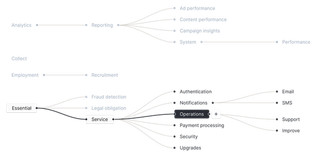One Company, One Data Language: The Foundation of Trustworthy AI Innovation
Trustworthy AI starts with speaking the same data language across the organization.
.jpeg?rect=186,0,2028,1350&w=320&h=213&fit=min&auto=format)
The Business Impact of Fragmented Taxonomy
In enterprises implementing AI, privacy officers, data governance specialists, and AI engineers often find themselves speaking fundamentally different languages when addressing the same data — creating a strategic risk to compliance, innovation, and responsible AI adoption.
This isn’t merely a communication challenge. It’s a strategic business risk that threatens compliance, innovation and responsible AI adoption.
Like the Tower of Babel—an ambitious project collapsing due to lack of a common language — organizations find their innovation initiatives constrained by a fragmented approach to taxonomy.
For executives looking to accelerate AI adoption while managing risk, one of the most overlooked barriers isn’t technical capability. A bigger challenge is the cultural inability of teams to communicate effectively about the data they hold and how it can be used.
This is due to different departments developing distinct languages to describe the same data:
- Privacy teams speak in terms of “personal data”, “processing purposes”, and “data subject rights” as defined by regulations like GDPR and CCPA
- Governance teams use language like “data assets”, “critical data elements” and “data quality metrics”
- Meanwhile, an AI team will talk about “training data” and “model inputs”
These are not merely semantic differences. When embedded in enterprise systems, these taxonomy conflicts create substantive strategic and operational risks.
“
Enterprise systems have long suffered from these taxonomy fragmentations, but the issues become increasingly risky as AI adoption accelerates, and this fragmentation represents a strategic leadership challenge that directly impacts business outcomes.”Ethyca Team
Consider what is at stake:
- Revenue impact: AI initiatives face long and costly implementation delays when privacy, governance and technical teams operate with conflicting data taxonomies.
- Unnecessary compliance costs accumulate when teams build multiple redundant solutions to the same fundamental problems — just because they’re using different terminology.
- Risk exposure grows when these differences across teams create blind spots in governance. What the AI team might view as harmless “user engagement metrics”, the privacy team recognizes as regulated “behavioral data” that requires specific, and often stringent, protections.
- Downstream, teams face confusion about what data can be used, for what purposes, and with what safeguards, leading to decision paralysis that prevents organizations from moving quickly on AI initiatives.
- Then, most ruinously of all, competitive disadvantage emerges because the organization has struggled to implement AI quickly and confidently — all while competitors with more unified approaches streak ahead into the distance.
AI systems can process and generate data at an unprecedented scale, meaning governance failures have an even greater negative impact. Tracking data lineage through the AI chain becomes significantly more complex. And with intensifying regulatory scrutiny, authorities everywhere increasingly expect organizations to adopt unified approaches to data governance.
For strategic business leaders, a unified data taxonomy across all data-rich teams and departments is the gold standard. First, it creates a foundation that enables consistent governance and second, it does so not just by getting out of the way of innovation, but actually accelerating it. It allows all teams to speak the same language, to solve the problem holistically rather than in fragmented silos.
Unified Taxonomy The Foundation for Cross-Functional AI Governance
A unified taxonomy is much more than a master glossary of terms. It’s a systematic approach to describing data that works across all enterprise functions.
Effective unified taxonomies share several key characteristics:
- Cross-functional applicability: The taxonomy must be equally useful to legal, technical and business teams, with each able to access what they need without specialized translation.
- Hierarchical structure: Clear relationships between concepts allow both high-level categorization (for executive and compliance reporting) and granular classification (for complex technical implementation).
- Machine-readability: The taxonomy must function not just in human communications but in the automated systems where policy enforcement increasingly happens.
- Integration of governance: The taxonomy should connect seamlessly to policy definitions, making it possible to express rules like “sensitive personal information cannot be used to train public-facing models” in a way all systems understand.
- Extensibility: As regulatory requirements change and new AI capabilities emerge, the taxonomy must evolve without requiring a complete redesign.
FideslangEnterprise-Grade Implementation for Unified Data Control
Ethyca’s Fideslang taxonomy was engineered specifically to address this enterprise-wide challenge, providing a robust, extensible foundation for unified data governance.
Fideslang provides a foundation — proven and trusted by global enterprises — that can be implemented across departments to create a single source of truth about data, organizing data into three components:
- Data Categories classify what type of data is being processed (for example, user.contact.email, user.demographic.gender, user.device.cookie_id), allowing for both broad and specific classification based on context.
- Data Uses describe how data is being used – examples in Fideslang include provide.service.operations, service.improve or marketing.advertising. This maps to both privacy “purposes” and AI “objectives” in a consistent framework.
- Data Subjects identify whose data is being processed (customer, employee, patient, job applicant or a range of other subjects), while providing critical context for legal compliance and AI innovation
This framework creates a powerful translation layer between technical systems and legal/compliance requirements. Below is a sample of how Data Uses are represented as nested, hierarchical elements in FidesLang that can be shared by all teams within an organization:

Take the above example. When an AI team wants to train a model on Service Operations data (customer email, SMS and support data) — they use the above taxonomy to express this in universal Fideslang terms that privacy, governance and engineering teams concretely understand, reducing redundancy and increasing the speed of team communications.
Extending the Taxonomy to AI Systems
For enterprises building responsible AI capabilities, a unified taxonomy delivers for compliance needs, but more than that, it becomes the foundational infrastructure for competitive innovation.
Fideslang’s extensible structure makes it particularly well-suited to explore the emerging opportunities of AI innovation, while still being robust enough for the challenges of AI governance. For example:
- Data Categories in Fideslang can be extended to classify AI training data, model outputs and synthetic data
- Data Uses can incorporate AI-specific purposes like model training, validation and inference
- Data Subjects remain consistent whether data is being processed by traditional applications or AI systems
Rather than building separate taxonomies for AI, companies leverage their Fideslang implementation to ensure consistent controls as they adopt advanced technologies — creating a seamless continuum from data collection to AI deployment.
The Competitive Edge of Unification
Organizations that successfully unify their data taxonomies gain significant competitive advantages beyond mere compliance:
- Reduced operational friction: Through the systematic responsible use of data, teams spend less time translating between different frameworks or patching problems, and more time innovating and adding value.
- Accelerated AI innovation: When privacy and governance controls are expressed in the same language as AI systems, development teams move faster with confidence that they’re operating within all appropriate guardrails.
- Preparedness for emerging regulations: As AI-specific regulations evolve, a unified approach provides the foundation for adapting quickly to new requirements without the costly headache of a fundamental restructuring.
- Enhanced trust across all stakeholders: The ability to consistently and comprehensively explain how data is used — from collection through AI processing — builds credibility internally and externally, from customers, regulators and partners to your existing team members and potential recruits, thus becoming a bedrock of brand guardianship.
The most forward-thinking organizations recognize that a unified taxonomy is about both risk mitigation, creating a strategic asset that enables innovation at scale — and doing so while strengthening the trust contract.
The Strategic Imperative One Company, One Data Language
As AI becomes increasingly central to business operations and innovation, speaking one consistent language across the whole enterprise — including privacy, governance, technology and marketing — is an essential foundation for sustainable and responsible growth.
The organizations that master this challenge will be the ones that succeed in deploying AI at scale while strengthening the trust of customers, employees and regulators.
They will be able to innovate more confidently, avoid the expensive mistakes that come from inefficient use — or inadvertent misuse — of data, and ultimately, move with speed and purpose.
The unified taxonomy challenge might have started out as a complex technical problem. That problem has evolved into a strategic opportunity to create a foundation for responsible AI that delivers sustainable competitive advantage, far into the future.Want to see how Fideslang is being used to unify AI policy and accelerate innovation at scale? Book a walkthrough with our team of taxonomy architects.
.jpeg?rect=801,0,3198,3198&w=320&h=320&fit=min&auto=format)

.jpeg?rect=1055,0,2690,2690&w=320&h=320&fit=min&auto=format)


.png?rect=0,3,4800,3195&w=320&h=213&auto=format)
.png?rect=0,3,4800,3195&w=320&h=213&auto=format)